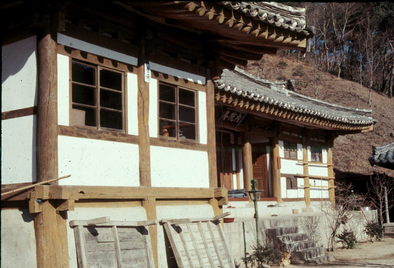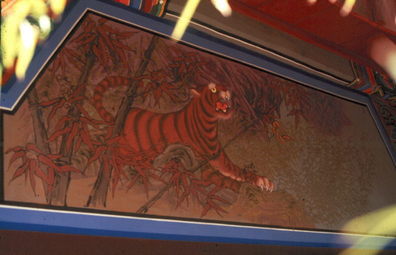 =0=
=0= =0=
=0= =0=
=0= =0=
=0= =0=
=0= =0=
=0= =0=
=0= =0=
=0= =0=
=0= =0=
=0= =0=
=0= =0=
=0=| Within each Buddhist shrine there are generally a few images of Buddha, three of which are shown here with the usual sort of decorations around them. |  =0=
=0= |
| This is a picture of the section of the monastery where the monks live. Dong Wah Sah is a pretty large monastery and has separate sections for women and men. When we wanted to have lunch, Mr. Nam asked if it would be alright and we had lunch in the cell where a monk would live. It is a simple cell about eight foot by eight foot with rice paper floor and no decorations and a place on the wall to hang things. When they are gone during the day for their various duties, the cells are empty and that is where we had our lunch. |  =0=
=0= |
| This is one of my favorite murals was of a tiger in a bamboo stand that was beside a stand of bamboo. It looked really cool, but I wasn't able to frame it as nicely as I would have liked. |  =0=
=0= |
| This is the last slide from Dong Wah Sah. Notice the Chinese characters on the sign (and I forgot why that was significant, or prehaps it wasn't and I forgot the real reason for including this slide). |  =0=
=0= |
| This next series of slides is from another temple, Hein Sah. This is a pretty typical shrine. |  =0=
=0= |
| At the entrance to each shrine there would be images of threatening characters which are intended to scare away evil spirits. |  =0=
=0= |
| This is a pciture of a pagoda or stupa. Just below and to the left of the carving you can see the back of woman in Hanbock or Korean traditional dress. You can tell she is a married woman as the tradition is that young girls let their hair grow and wear in loose while married women continue to let their hair grow while keeping it up in a bun as here. The more modern thing for married women to do is to cut it short and curl it a little as you can see with the mom and her kids. |  =0=
=0= |
| Hein Sah is famous for having ancient wood carvings with Chinese characters and the teachings of Buddha. The images are reversed so that the wood blocks can be used to print the teachings. These blocks are about 800 to 1,000 years old, but are actually the second set as the older set was burned. They would have dated from about 1,200 years ago. |  =0=
=0= |
| This is how the blocks are stored. Just rows and rows of shelves with them. As they are wooden blocks there is not really much way to save space. I imagine we could fit the whole thing on a single microfiche (then in 1978) or a single CD today. |  =0=
=0= |
| This is the exterior of one of the two long buildings where the carvings are stored. The buildings are open air in that the vents you see to let in light are just wooden bars. This is also only one half of the building in that the building extends on about that length to the right of the picture and the other building is just across this courtyard and to the left of this picture. |  =0=
=0= |
| This is the main shrine a Hein Sah. |  =0=
=0= |
| This is shrine under construction. Plain wood is used to build the walls and ceiling and then they start to fill in the wall and add the carvings and decorations. |  =0=
=0= |
This page was last updated on September 5, 2005.